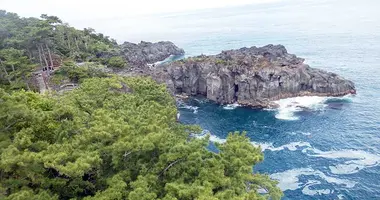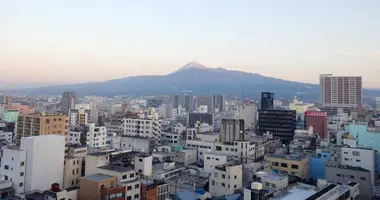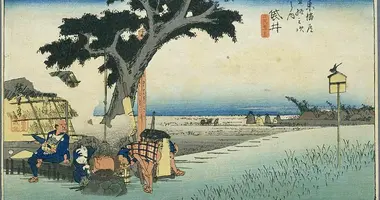Ito Guide Izu Peninsula Shizuoka
- Published on : 30/06/2018
- by : Japan Experience
- Youtube
Ito is a hot spring resort town on the eastern shore of the Izu peninsula. It is within easy reach of both Tokyo and Yokohama.
- Central Ito
- Exploring Ito
- Tokaikan
- Matsukawa River
- Mokutaro Kinoshita
- Mokutaro Kinoshita Museum
- Nagisa and Anjin Memorial Park
- William Adams
- Places to stay in and around Ito City
- How to get to Ito
- Japan City Guides
Ito City, Izu Peninsula, Shizuoka Prefecture 伊東市 伊豆半島 静岡県
Johannes Schonherr

Seaside view of Ito, Izu Peninsula, Shizuoka Prefecture
Ito is a hot spring resort town on the eastern shore of the Izu Peninsula, southwest of Tokyo and Yokohama, with a population close to 70,000.
The town's territory (actually, Ito is classified as a city) stretches far from its urban area towards the south and encompasses Mount Omuro, the Jogasaki Coast and other natural sites of volcanic origin. A large part of the rural south of Ito is part of both the Fuji-Hakone-Izu National Park and at the same time, part of the Izu Peninsula Geo Park.
Ito proper is located at the JR Ito Line running from Atami to Ito. From Ito, the train line continues on as the private Izu Kyuko Line to Shimoda in the very south of the Izu Peninsula.
Given its convenient train connections to Tokyo and other towns further down the Izu Peninsula as well as its abundance of hotels of all categories, Ito makes for a very good base to stay when exploring the Izu Peninsula.
The Tokai Bus Company, operating throughout the Izu Peninsula, makes Ito Station one of its major transportation hubs, offering day passes that allow for convenient travel in the wider Ito area. Find detailed information in English here.

Yu-no-Hana Dori Shopping Street in downtown Ito, Izu Peninsula
Central Ito
Central Ito, roughly the area within walking distance of Ito Station, offers its own attractions.
The central part of the city is framed by hills, with many hotels built high up on the slopes, facing a rugged coast.
Though dominated by the many hot spring hotels within and surrounding the city center, Ito is a rather quiet town. The hot spring visitors tend to book all-inclusive packages with meals provided in the dining rooms of their hotels. Thus, no matter how many tourists may stay in the city, the streets are quiet at night.
For those venturing out on their own, there are a few excellent seafood restaurants downtown. The hotels hand out maps with the locations and short descriptions of those restaurants (in Japanese).
The traditional Marugen restaurant for example, located on the vintage Yu-no-Hana Dori shopping street in downtown Ito, provides an excellent selection of local seafood in a rustic atmosphere.
Downtown Ito also sports a good number of public onsen hot spring baths.

Entrance to the Tokaikan, Ito, Izu Peninsula

Matsukawa River Walk, Ito, Izu Peninsula
Exploring Ito
Enter Icho Dori, the shopping street starting just across the little plaza in front of the train station and follow it until you reach a bridge named the Ideyu Bridge after about 5 minutes, crossing the Matsukawa River.
Alternatively, walk through the more traditional Yu-no-Hana Dori shopping street, starting a bit to the right of Ito Station. The street will converge with Icho Dori.
From Ideyu Bridge, you will see an impressive building on your left: the Tokaikan.

Tokaikan with Matsukawa River, Ito
Tokaikan
The Tokaikan in the very heart of downtown Ito is the city's signature building. Erected as a large hotel in 1928, it was reconstructed in 1938 to accommodate the increasingly larger tour groups arriving by then. The reconstruction resulted in much larger rooms, giving the feel of a very generous use of space.
After the hotel closed its doors in 1997, it was re-opened as a museum in 2001.
Today's Tokaikan is not just a grand old wooden building with tatami floors, offering good views the Matsukawa River.
It features also a hot spring bath, a classic tea room and, perhaps most beneficial for visitors interested in the city's history, it offers plenty of informative exhibitions on the three most celebrated people associated with the city's history: William Adams, known as the "blue-eyed samurai", writer, painter and leprosy doctor Mokutaro Kinoshita, a native of the city, as well as sculptor Kenji Shigeoka.
All three of them have left their distinctive marks on the city, touched upon further below.

Sculptures by Kenji Shigeoka at Nagisa Park, Ito
Matsukawa River
The Matsukawa River crosses through the center of Ito. Between Otonashi Shrine with its giant camphor trees and the Sagami Bay Coast (with the Tokaikan located in about the middle), a pedestrian / bicycle path runs along the river.
Lined by cherry trees, the river walk is a popular spot especially during the sakura cherry blossom season in late March / early April.
Replications of Mokutaro Kinoshita's drawings are exhibited all along the river, including an impressive rendering of the river's causeway in 1903. The drawings are often accompanied by poems Kinoshita wrote.

Mouth of the Matsukawa River rendered by Mokutaro Kinoshita in 1903 and displayed on the Matsukawa River Walk
Mokutaro Kinoshita
Mokutaru Kinoshita (1885-1945) is Ito's most celebrated native. He was born in 1885 as the youngest of 10 children to a wealthy merchant family as Masao Ota. He studied medicine and became a medical doctor, most famous for his research on leprosy.
Seeking a cure for the illness, Masao Ota was an outspoken critic of the internment of leprosy patients common in Japan during the first half of the 20th century.
While he used his birth name for his medical research and publications, he chose the pen name Mokutaro Kinoshita for his writing and drawings.

Kinoshita Mokutaro Museum, Ito
Mokutaro Kinoshita Museum
The Mokutaro Kinoshita Museum, only a short walk from the Tokaikan, is located in Kinoshita's birth house. Erected in 1835, the former house of Kinoshita's family is one of the oldest buildings in Ito.
In addition to a large variety of Kinoshita's writings and drawings on exhibit, the house is a beautiful example of an Edo Era merchant mansion with a courtyard and many traditional rooms, giving a good glimpse at the ways of living back then.
Nagisa and Anjin Memorial Park
At the mouth of the Matsukawa River, two parks line the coast. On the northern side is Nagisa Park, a seaside sculpture park featuring a wide variety of works by Kenji Shigeoka.
Shigeoka, born in Manchuria in 1936, grew up in Ito. Today, he is one of Japan's most celebrated sculptors.
One of his most famous works is his statue of William Adams, located in the Anjin Memorial Park just across the river from Nagisa Park.

Bust of William Adams by Kenji Shigeoka at Anjin Memorial Park, Ito
William Adams
William Adams (1564-1620), known in Japanese as Miura Anjin, is considered to be the first Englishman to have set foot in Japan. He arrived at the port of Usuki, Kyushu on board a Dutch vessel in 1600.
The travel had been rough and many sailors had died before the ship reached Japan. Upon arrival, Usuki-based Portuguese missionaries conspired against the sailors of the Liefde, the Dutch ship, claiming they were pirates and needed to be executed.
Instead, the surviving sailors were imprisoned at Osaka Castle on the orders of Shogun Ieyasu Tokugawa. Ieyasu himself met the sailors in Osaka several times and he was especially impressed by William Adams.
Soon, Adams became one of Ieyasu's top advisors on all things Western. Ieyasu also instructed Adams, who was adept at ship building, to construct the first Western style ships made in Japan.
The wharf for those ships was in Ito, roughly in the area today covered by the Nagisa and Anjin Memorial Parks.
The wharf has its own monument with a large image of Adams instructing the ship builders set in the pavement, located on the southern bank of the Matsukawa River just across the street from Anjin Memorial Park.
One of the ships built there soon became famous: the San Bueno Ventura.
When a Spanish shipwreck left more than 300 Spanish sailors stranded on the shore of Chiba in 1609, the San Bueno Ventura was used to take them back to Mexico, where they had come from.
It was the first time a Japanese ship crossed the Pacific Ocean and reached the coast of the Americas. (Adams himself didn't join that trip, though. Spain and England were at war at the time.)
A group of Japanese researchers went with the Spaniards, staying on in Mexico to study silver mining before they were eventually returned to Japan.
Ieyasu elevated Adams to the rank of samurai and afforded him great privileges including a large estate in Hirado near Nagasaki. Adams died in Hirado in 1620 at age 55.

Sketches of William Adams made during his lifetime, Tokaikan, Ito
Tokai Kisen Ferry Terminal
If all the memorials to William Adams' sailing adventures make you feel like taking a little boat trip yourself, the Tokai Kisen Ferry Terminal is right next to Anjin Memorial Park. It offers daily trips to Izu Oshima Island as well as to Hatsushima Island.
Tokai Kisen English language website www.tokaikisen.co.jp/english
Places to stay
Ito has a wide range of places to stay, from cheap hostels to high class hotels and ryokan (traditional Japanese inns). These include the Higashi Izu Koyoi, a three-star ryokan with views of the ocean from its baths, the four star Laforet Ito Onsen Yunoiwa with spacious rooms and delicious food, the Hotel Harvest Ito, also four star with outdoor baths and indoor pool and the superb Yokikan offering traditional tatami floors, futon bedding and huge multi-course meals.
Hotel Albergo is a converted love hotel offering fairly reasonable accommodation without meals.

Central Ito, Izu Peninsula, Shizuoka Prefecture
Access - Getting to Ito
Go to Atami Station in Atami on the JR Tokaido Line or a Kodama train of the Tokaido Shinkansen Line. Change there to the JR Ito Line towards Izukyu Shimoda in Shimoda at the base of the Izu Peninsula. Get off at Ito Station.
Tokaikan
Access: about a 5 minute walk from Ito Station
Opening times: Daily 9 am to 9 pm, closed on the 3rd Tuesday of every month. If that day is a public holiday, the Tokaikan will be closed the next day. Closed on January 1st.
Admission: adult 200 yen, children 100 yen
Tea room: 10 am to 5 pm
Onsen: Open only Saturday, Sunday and holidays. Male and female visiting times alternate. Admission: adult 500 yen, children 300 yen.
Address: Higashi Matsubaracho 12-10, Ito-shi
Tel: 0557 36 2004
Kinoshita Mokutaro Museum
Access: 5 minute walk from Ito Station, very short walk from the Tokaikan.
Opening times: April through September 9 am to 4.30 pm, October through March 9 am to 4 pm. Closed on Monday, Tuesday if Monday is a national holiday.
Admission: Adult 100 yen, children 80 yen
Address: Yukawa 2-chome 11-5, Ito-shi
Tel: 0557 36 7454
Ito City English language website itospa.com/ito-city-english-tour-guide


















